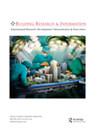Managing crises ‘together’: how can the built environment contribute to social resilience?
IF 3.7
3区 工程技术
Q1 CONSTRUCTION & BUILDING TECHNOLOGY
引用次数: 3
Abstract
ABSTRACT The world is undergoing multiple crises that require resilience to withstand them. The built environment can significantly enhance or weaken society’s (and individuals’) resilience. However, understanding of resilience in the built environment is scattered and manifold – whilst the design of buildings primarily focuses on the restoration of buildings’ physical characteristics, urban policies centre on the recovery of society. Scholars highlight the need for a holistic approach where different resilience concepts merge to improve the resilience of people and communities. For this, understanding the relationship between people and places is crucial. Thus, the aim of this paper is to deepen the understanding of the social resilience concept in relation to the built environment and how the built environment can enhance it. This is achieved through an extensive literature review, concept mapping and panel discussion. The built environment characteristics affecting individual and/or community resilience are identified, and a conceptual model is provided, attempting to visualize the relationship between the constructs. The paper’s novelty lies in its multidisciplinary approach and integration of various social science knowledge in the context of the built environment. Furthermore, it emphasizes the built environment’s role in supporting social resilience, which has been often overlooked previously.“共同”管理危机:建筑环境如何有助于提高社会韧性?
摘要世界正在经历多重危机,需要有抵御能力。建筑环境可以显著增强或削弱社会(和个人)的韧性。然而,对建筑环境弹性的理解是分散的和多方面的——虽然建筑设计主要侧重于恢复建筑的物理特征,但城市政策侧重于社会的恢复。学者们强调,需要采取一种全面的方法,将不同的复原力概念融合在一起,以提高人们和社区的复原力。为此,理解人与地之间的关系至关重要。因此,本文的目的是通过广泛的文献综述、概念映射和小组讨论,加深对与建筑环境相关的社会复原力概念的理解,以及建筑环境如何增强它。确定了影响个人和/或社区复原力的建筑环境特征,并提供了一个概念模型,试图将结构之间的关系可视化。这篇论文的新颖之处在于它采用了多学科的方法,并在建筑环境的背景下整合了各种社会科学知识。此外,它强调了建筑环境在支持社会韧性方面的作用,而这在以前经常被忽视。
本文章由计算机程序翻译,如有差异,请以英文原文为准。
求助全文
约1分钟内获得全文
求助全文
来源期刊

Building Research and Information
工程技术-结构与建筑技术
CiteScore
8.60
自引率
7.70%
发文量
43
审稿时长
>12 weeks
期刊介绍:
BUILDING RESEARCH & INFORMATION (BRI) is a leading international refereed journal focussed on buildings and their supporting systems. Unique to BRI is a focus on a holistic, transdisciplinary approach to buildings and the complexity of issues involving the built environment with other systems over the course of their life: planning, briefing, design, construction, occupation and use, property exchange and evaluation, maintenance, alteration and end of life. Published articles provide conceptual and evidence-based approaches which reflect the complexity and linkages between cultural, environmental, economic, social, organisational, quality of life, health, well-being, design and engineering of the built environment.
 求助内容:
求助内容: 应助结果提醒方式:
应助结果提醒方式:


